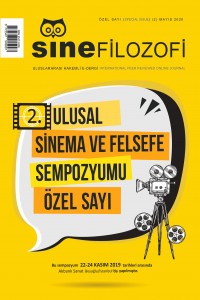Öz
Neuro-image is a concept follows up movement-image and time-image, generated by Patricia Pisters through Deleuze cinematography in the aim of characterize and clarify the new cinematographic image which has been assemblaged by neuroscientific and cognitive progresses based on the political occasion of demolition of Berlin Wall and 9/11. It belongs to third synthesis of time, future and formed in parallel neuroscienetifical and online internet cultural develepments. It's a cinematographic image is synthesized at the 3th synthesis under the political effect of pre-emptive design of future. The cinematography appeared in 21th century cinema that we see world within characters minds, not through eyes is assemblaged by themes which are given a lead by online and neuroscientific progresses. Patricia Pisters approached this new cinematographic component in the frame of Deleuze-Guattari schizoanalysis, researched in the frame of "brain is screen", brainscreens and conceptualized. In this paper, neuro-image at the 3th synthesis of time, brain screens and cognitive architectures in Black Mirror serial, Netflix, detected and explained in the aim of introducing neuro-image concept to Turkey cinema field and schizoanalysis utilized as a practice.
Anahtar Kelimeler
neuroimage deleuze guattari patriciapisters blackmirror cinema cinematography
Kaynakça
- Baudrillard, J. (1995). The Gulf War did not take place. Indiana University Press.
- Bergson, H. (1920). Mind-energy: Lectures and essays. H. Holt.
- Connolly, W. E. (2002). Neuropolitics: Thinking, culture, speed (Vol. 23). U of Minnesota Press.
- Deleuze, G., & McMuhan, M. (1998). The Brain Is the Screen: Interview with Gilles Deleuze on "The Time-Image". Discourse, 20(3), 47-55. Retrieved from www.jstor.org/stable/41389498
- Deleuze, G. (2013). Cinema II: the time-image. Bloomsbury Publishing.
- Deleuze, G. (2014). Sinema I Hareket-İmge. İstanbul: Norgunk Yayıncılık, 162.
- Deleuze, G., & Guattari, F. (2014). Anti-Ödipus, Kapitalizm ve Şizofreni 1, çev. Fahrettin Ege, Hakan Erdoğan ve Mustafa Yiğitalp, Ankara: Bilim ve Sosyalizm.
- Deleuze, G. (2010). Nietzsche ve Felsefe, çev. Ferhat Taylan, Norgunk Yayıncılık, İstanbul.
- Deleuze, G. (2017). Fark ve Tekrar, çev. Burcu Yalım ve Emre Koyuncu, 1.
- Derrida, J. (1996). Archive fever: A Freudian impression. University of Chicago Press.
- Hauptmann, D., & Neidich, W. (2010). Cognitive Architecture: From Bio-Politics to Noo-Politics; Architecture & Mind Inthe Age of Communication and Information.
- Manovich, L. (2002). The language of new media. MIT press.
- Neidich, W. (2009). Neuropower. Atlantica Magazine of Art and Thought, 48(49), 119-65.
- Pisters, P. (2012). The neuro-image: A Deleuzian film-philosophy of digital screen culture. Stanford University Press.
- Ronfeldt, D., & Arquilla, J. (2018). The Continuing Promise of the Noösphere and Noöpolitik: Twenty Years After. Available at SSRN 3259425.
- Virilio, P. (1989). War and cinema: The logistics of perception. Verso.
- Filmler)
- Bress, E. & Gruber, J. M. (2004). Kelebek Etkisi (The Butterfly Effect). ABD
- Brooker, C. (2011-günümüz). Black Mirror (Dizi). ABD.
- Schalk, R. (2017-günümüz). Dark (Dizi). ABD.
- Palma, B. (2014). Redacted. ABD.
- Pontecorvo, G. (1966). Cezayir Savaşı (La Battaglia di Algeri). (Film). İtalya.
Öz
Nöro imge Patricia Pisters’ın Berlin Duvarı’nın yıkılışı ve 9/11’in politik olarak zeminlediği nörobilimsel ve bilişimsel değişimlerin hazırladığı yeni bir sinematografik imgeyi tanımlayıp açıklamak için Deleuze’ün sinematografik yaklaşımı doğrultusunda ürettiği, hareket imge ve zaman imgeyi takip eden bir kavramdır. Zamanın üçüncü sentezine, gelecek zamana ait olan nöro imge nörobilimsel gelişmeler ve internet çevrimli kültürel gelişmelerle paralel ortaya çıkmıştır. Geleceğin önalımsal tasarlanmasının politik etkisi altında gelecek zamanda sentezlenen sinematografik imgedir. 21. YY sinemasında nörobilimsel ve çevrimsel gelişmelerin yol açtığı temaların bir arada kullanılmasıyla karakterlerin gözünden değil, zihninin içinden, beyin ekranlar aracılığıyla izlediğimiz bir sinematografi ortaya çıkmıştır. Patricia Pisters bu yeni sinematografik ögeyi Deleuze-Guattarici şizoanaliz çerçevesinde ele alarak nöro imge diye kavramsallaştırmış, “beyin ekrandır”, beyin ekranlar çerçevesinde incelemiştir. Bu çalışmada nöro-imgeyi bilim alanına tanıtmak amacıyla Netflix, Black Mirror dizisinde zamanın üçüncü sentezinde yer alan nöro imge, beyin ekranlar ve onlara eşlik eden zihin mimarileri bulgulanıp açıklanmıştır. Bu amaç doğrultusunda şizoanaliz yöntem olarak kullanılmıştır.
Anahtar Kelimeler
nöro-imge BlackMirror sinema sinematografi Deleuze Guattari PatriciaPisters
Kaynakça
- Baudrillard, J. (1995). The Gulf War did not take place. Indiana University Press.
- Bergson, H. (1920). Mind-energy: Lectures and essays. H. Holt.
- Connolly, W. E. (2002). Neuropolitics: Thinking, culture, speed (Vol. 23). U of Minnesota Press.
- Deleuze, G., & McMuhan, M. (1998). The Brain Is the Screen: Interview with Gilles Deleuze on "The Time-Image". Discourse, 20(3), 47-55. Retrieved from www.jstor.org/stable/41389498
- Deleuze, G. (2013). Cinema II: the time-image. Bloomsbury Publishing.
- Deleuze, G. (2014). Sinema I Hareket-İmge. İstanbul: Norgunk Yayıncılık, 162.
- Deleuze, G., & Guattari, F. (2014). Anti-Ödipus, Kapitalizm ve Şizofreni 1, çev. Fahrettin Ege, Hakan Erdoğan ve Mustafa Yiğitalp, Ankara: Bilim ve Sosyalizm.
- Deleuze, G. (2010). Nietzsche ve Felsefe, çev. Ferhat Taylan, Norgunk Yayıncılık, İstanbul.
- Deleuze, G. (2017). Fark ve Tekrar, çev. Burcu Yalım ve Emre Koyuncu, 1.
- Derrida, J. (1996). Archive fever: A Freudian impression. University of Chicago Press.
- Hauptmann, D., & Neidich, W. (2010). Cognitive Architecture: From Bio-Politics to Noo-Politics; Architecture & Mind Inthe Age of Communication and Information.
- Manovich, L. (2002). The language of new media. MIT press.
- Neidich, W. (2009). Neuropower. Atlantica Magazine of Art and Thought, 48(49), 119-65.
- Pisters, P. (2012). The neuro-image: A Deleuzian film-philosophy of digital screen culture. Stanford University Press.
- Ronfeldt, D., & Arquilla, J. (2018). The Continuing Promise of the Noösphere and Noöpolitik: Twenty Years After. Available at SSRN 3259425.
- Virilio, P. (1989). War and cinema: The logistics of perception. Verso.
- Filmler)
- Bress, E. & Gruber, J. M. (2004). Kelebek Etkisi (The Butterfly Effect). ABD
- Brooker, C. (2011-günümüz). Black Mirror (Dizi). ABD.
- Schalk, R. (2017-günümüz). Dark (Dizi). ABD.
- Palma, B. (2014). Redacted. ABD.
- Pontecorvo, G. (1966). Cezayir Savaşı (La Battaglia di Algeri). (Film). İtalya.
Ayrıntılar
| Birincil Dil | Türkçe |
|---|---|
| Konular | Felsefe |
| Bölüm | Konferans Bildirisi |
| Yazarlar | |
| Yayımlanma Tarihi | 29 Mayıs 2016 |
| Yayımlandığı Sayı | Yıl 2020 Özel Sayı (2) Mayıs 2020 |

